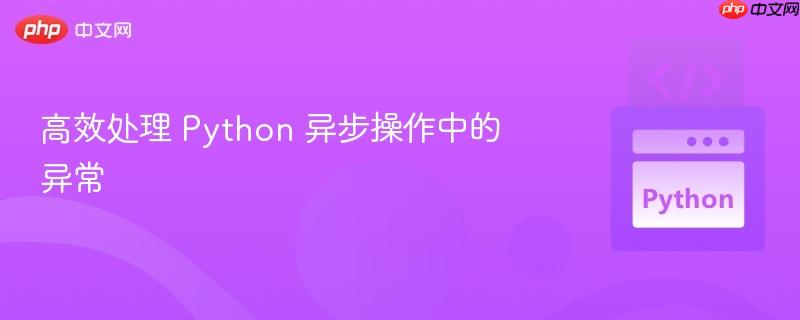
本文旨在提供一种在 Python 的 asyncio 框架下,高效处理异步操作中异常的方法。重点在于如何在单个任务发生异常时,避免影响其他并发任务的执行,从而保证程序的健壮性和稳定性。我们将通过代码示例展示如何在异步函数内部进行异常处理,确保即使出现错误,程序也能继续执行。
在 Python 中使用 asyncio 进行异步编程时,一个常见的需求是同时执行多个任务。asyncio.gather 函数能够很好地满足这个需求,但同时也带来了一个潜在的问题:当其中一个任务发生异常时,默认情况下会中断整个 asyncio.gather 的执行,导致其他任务无法完成。为了解决这个问题,我们需要在每个异步任务内部进行异常处理,从而保证程序的健壮性。
以下是一个示例代码,展示了如何在异步函数内部处理异常:
import asyncio
async def task_one():
try:
# 模拟可能发生异常的代码
print(hello) # 这里会引发 NameError 异常
except Exception as e:
print('Exception found in task_one:', e)
finally:
print('task_one finished')
async def task_two():
print("Task Two is running")
await asyncio.sleep(1) # 模拟耗时操作
print("Task Two finished")
async def main():
await asyncio.gather(task_one(), task_two())
if __name__ == "__main__":
asyncio.run(main())代码解析:
立即学习“Python免费学习笔记(深入)”;
运行结果:
Exception found in task_one: name 'hello' is not defined task_one finished Task Two is running Task Two finished
注意事项:
总结:
通过在每个异步任务内部进行异常处理,我们可以有效地避免单个任务的异常影响整个 asyncio.gather 的执行。这种方法能够提高程序的健壮性和稳定性,确保即使在出现错误的情况下,程序也能继续执行。同时,合理的异常处理机制也有助于我们更好地定位和解决问题。
以上就是高效处理 Python 异步操作中的异常的详细内容,更多请关注php中文网其它相关文章!

每个人都需要一台速度更快、更稳定的 PC。随着时间的推移,垃圾文件、旧注册表数据和不必要的后台进程会占用资源并降低性能。幸运的是,许多工具可以让 Windows 保持平稳运行。

Copyright 2014-2025 https://www.php.cn/ All Rights Reserved | php.cn | 湘ICP备2023035733号